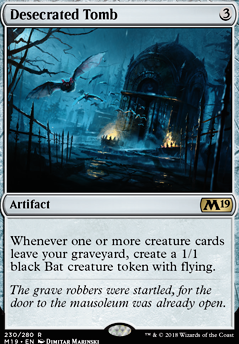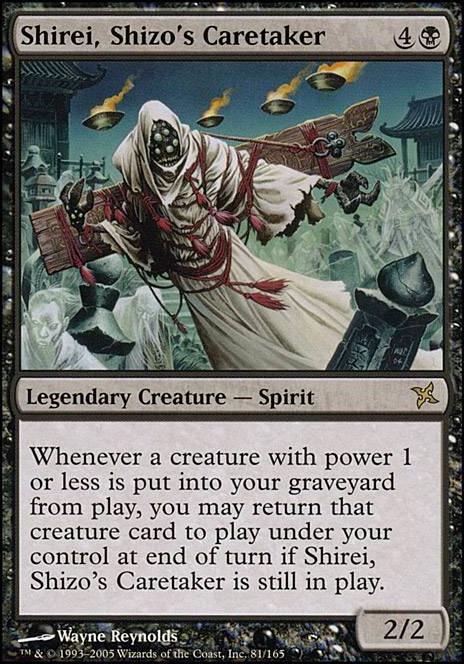
<PRIMER> Shirei, Guiding the Dead </PRIMER>
Commander / EDH Aristocrats Mono-Black Primer Value Engine Weenie
Creature (41)
- 1x Abyssal Gatekeeper
- 1x Blood Artist
- 1x Blood Pet
- 1x Bloodthrone Vampire
- 1x Bone Shredder
- 1x Bottle Gnomes
- 1x Cadaver Imp
- 1x Carrion Feeder
- 1x Crypt Ghast
- 1x Crypt Rats
- 1x Dusk Legion Zealot
- 1x Dutiful Attendant
- 1x Fume Spitter
- 1x Gleaming Barrier
- 1x Grim Haruspex
- 1x Heap Doll
- 1x Hell's Caretaker
- 1x Marsh Flitter
- 1x Mesmeric Fiend
- 1x Midnight Reaper
- 1x Mindless Automaton
- 1x Myr Retriever
- 1x Overeager Apprentice
- 1x Pawn of Ulamog
- 1x Perilous Myr
- 1x Phyrexian Plaguelord
- 1x Pitiless Plunderer
- 1x Plagued Rusalka
- 1x Priest of Forgotten Gods
- 1x Serrated Scorpion
- 1x Sifter of Skulls
- 1x Skyscanner
- 1x Smothering Abomination
- 1x Soldevi Adnate
- 1x Sorceress Queen
- 1x Tattered Mummy
- 1x Thoughtpicker Witch
- 1x Undertaker
- 1x Viscera Seer
- 1x Yarok's Fenlurker
- 1x Zulaport Cutthroat
Enchantment (10)
- 1x Attrition
- 1x Bastion of Remembrance
- 1x Dark Privilege
- 1x Dark Prophecy
- 1x Dictate of Erebos
- 1x Gift of Doom
- 1x Grave Pact
- 1x Pestilence
- 1x Phyrexian Reclamation
- 1x Vampiric Rites
Artifact (8)
- 1x Ashnod's Altar
- 1x Claws of Gix
- 1x Desecrated Tomb
- 1x Lightning Greaves
- 1x Sol Ring
- 1x Swiftfoot Boots
- 1x Wayfarer's Bauble
- 1x Whispersilk Cloak
Sorcery (1)
Commander (1)
Instant (5)
- 1x Drag to the Underworld
- 1x Go for the Throat
- 1x Mausoleum Secrets
- 1x Sudden Spoiling
- 1x Tragic Slip
Land (34)
Maybeboard
Creature (19)
- 1x Big Game Hunter
- 1x Burglar Rat
- 1x Cauldron Familiar
- 1x Disciple of Phenax
- 1x Falkenrath Noble
- 1x Fell Specter
- 1x Festercreep
- 1x Festering Mummy
- 1x Festering Newt
- 1x Fourth Bridge Prowler
- 1x Kaervek, the Spiteful
- 1x Kuro, Pitlord
- 1x Mindlash Sliver
- 1x Sadistic Hypnotist
- 1x Serrated Biskelion
- 1x Weaponcraft Enthusiast
- 1x Withered Wretch
- 1x Xiahou Dun, the One-Eyed
- 1x Yawgmoth, Thran Physician
Land (9)
Enchantment (15)
- 1x Black Market
- 1x Fallen Ideal
- 1x Fevered Convulsions
- 1x Foul Presence
- 1x Glistening Oil
- 1x Grave Pact
- 1x Infernal Tribute
- 1x Necropotence
- 1x Night of Souls' Betrayal
- 1x No Rest for the Wicked
- 1x Open the Graves
- 1x Oversold Cemetery
- 1x Palace Siege
- 1x Skeletal Grimace
- 1x Tortured Existence
Instant (9)
Sorcery (12)
- 1x Bitter Ordeal
- 1x Black Sun's Zenith
- 1x Command the Dreadhorde
- 1x Damnation
- 1x Demonic Tutor
- 1x Diabolic Intent
- 1x Dread Return
- 1x Exsanguinate
- 1x Living Death
- 1x Necromantic Selection
- 1x Reanimate
- 1x Toxic Deluge
Artifact (12)
Suggestions
Comments View Archive
Attention! Complete Comment Tutorial! This annoying message will go away once you do!
Important! Formatting tips — Comment Tutorial — markdown syntax
Please login to comment
94% Casual
Competitive
| Date added | 3 years |
| Last updated | 3 years |
| Legality | This deck is Commander / EDH legal. |
| Rarity (main - side) | 19 - 0 Rares 23 - 0 Uncommons 25 - 0 Commons |
| Cards | 100 |
| Avg. CMC | 2.58 |
| Tokens | Bat 1/1 B, Eldrazi Scion 1/1 C, Eldrazi Spawn 0/1 C, Goblin Rogue 1/1 B, Human Soldier 1/1 W, Morph 2/2 C, Treasure |
| Folders | Others decks, References, EDH |
| Votes | |
| Ignored suggestions | |
| Shared with | |
| Views |

